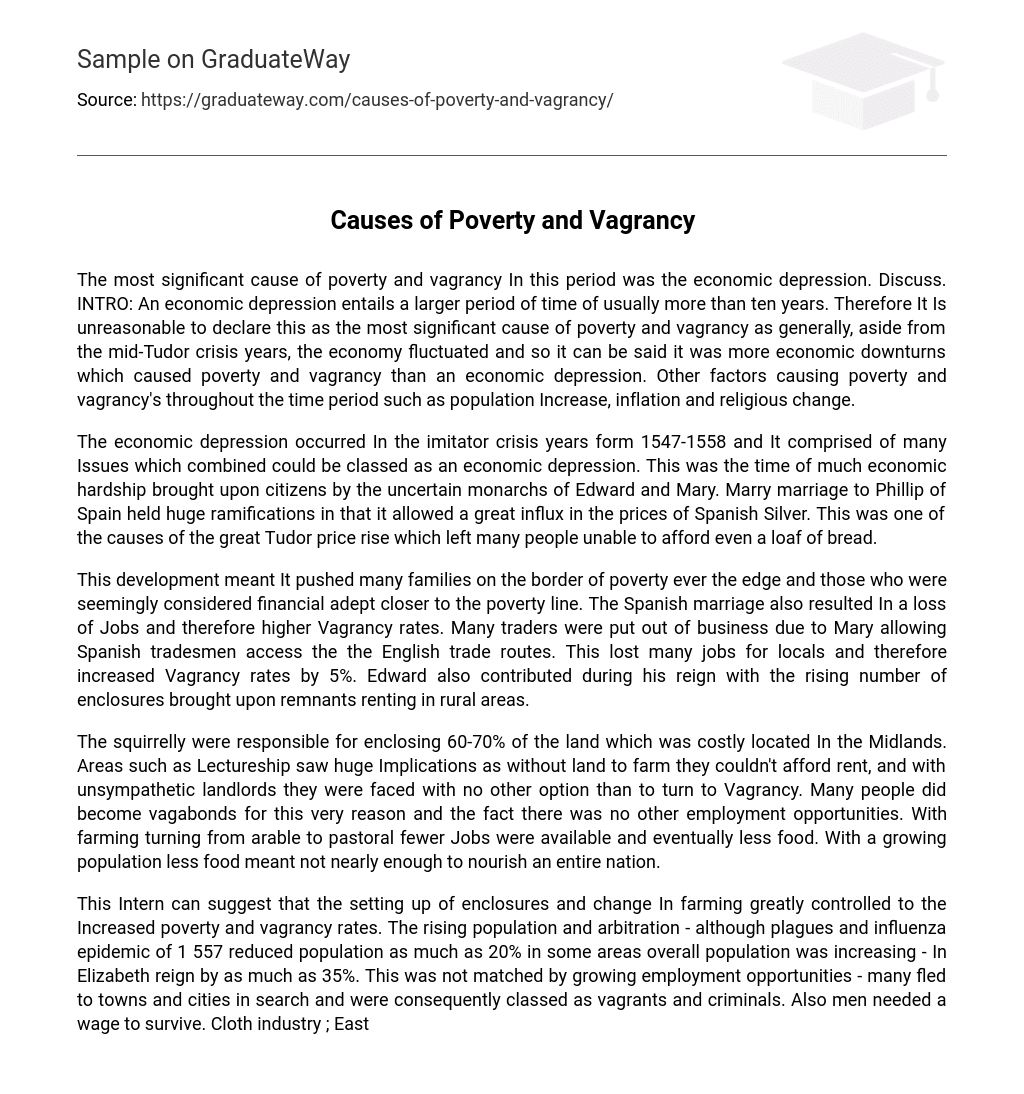The most significant cause of poverty and vagrancy In this period was the economic depression. Discuss. INTRO: An economic depression entails a larger period of time of usually more than ten years. Therefore It Is unreasonable to declare this as the most significant cause of poverty and vagrancy as generally, aside from the mid-Tudor crisis years, the economy fluctuated and so it can be said it was more economic downturns which caused poverty and vagrancy than an economic depression. Other factors causing poverty and vagrancy’s throughout the time period such as population Increase, inflation and religious change.
The economic depression occurred In the imitator crisis years form 1547-1558 and It comprised of many Issues which combined could be classed as an economic depression. This was the time of much economic hardship brought upon citizens by the uncertain monarchs of Edward and Mary. Marry marriage to Phillip of Spain held huge ramifications in that it allowed a great influx in the prices of Spanish Silver. This was one of the causes of the great Tudor price rise which left many people unable to afford even a loaf of bread.
This development meant It pushed many families on the border of poverty ever the edge and those who were seemingly considered financial adept closer to the poverty line. The Spanish marriage also resulted In a loss of Jobs and therefore higher Vagrancy rates. Many traders were put out of business due to Mary allowing Spanish tradesmen access the the English trade routes. This lost many jobs for locals and therefore increased Vagrancy rates by 5%. Edward also contributed during his reign with the rising number of enclosures brought upon remnants renting in rural areas.
The squirrelly were responsible for enclosing 60-70% of the land which was costly located In the Midlands. Areas such as Lectureship saw huge Implications as without land to farm they couldn’t afford rent, and with unsympathetic landlords they were faced with no other option than to turn to Vagrancy. Many people did become vagabonds for this very reason and the fact there was no other employment opportunities. With farming turning from arable to pastoral fewer Jobs were available and eventually less food. With a growing population less food meant not nearly enough to nourish an entire nation.
This Intern can suggest that the setting up of enclosures and change In farming greatly controlled to the Increased poverty and vagrancy rates. The rising population and arbitration – although plagues and influenza epidemic of 1 557 reduced population as much as 20% in some areas overall population was increasing – In Elizabeth reign by as much as 35%. This was not matched by growing employment opportunities – many fled to towns and cities in search and were consequently classed as vagrants and criminals. Also men needed a wage to survive. Cloth industry ; East Anglia in particular was dependent on the cloth industry.
Areas such as Suffolk, Devon and lavender all needed the cloth industry to survive – however it was controlled by external events. Wars with Spain and problems with the Netherlands in the 1580-ass meant that trade was extremely difficult and it was harsh on the urban wage-earner. When an unexpected turn occurred many turned to industry despite its problems employed far more people than any other trade excluding agriculture. This all changed with the change from arable to pastoral farming where landlords found if they enclosed their land and allowed people to arm livestock rather than crops they could gain a 50% increase on their income.
Pastoral farming however had less Job opportunities. Midlands with lectureship in particular suffered most – squirrelly enclosed 60%-70% of the land. Thousands of men lost their livelihood in this time period within Lectureships alone a third of 31 acres was enclosed. JOHN HALES – GREAT SOCIAL EVIL AND THE CAUSE OF MUCH DISTRESS ; Inflation + popularization – even if Job opportunities were rife the wage earner was at the mercy of inflation rates. The great debasement of coinage in the sass meant that silver in coins was reduced by as much as 2 thirds.
Spanish silver influx due to the marriage of Phillip and Mary. Inflation rates and enclosures were seen as important causes which is why Elizabeth brought in the poor law of 1572 whereby a compulsory poor tax was introduced. ; Racketing – increased rent rates on threat of eviction landlords used this technique in the mid Tudor crisis years in particular. There was a lack in hospitality from landlords and people in general – they left it to the parishes to deal with. A lack of comfort prevailed in Wales. Religion was also a cause of poverty and vagrancy.
The dissolution of the monasteries meant that paupers who previously seeded refuge in monasteries could no longer do so and many were pushed into begging. Prior to the dissolution 6,4% of Norwich cathedrals income went toward the paupers. Monks became vagrants however some had pensions though these changed with inflation so many had to beg. Nuns on the Teheran were far worse off as they were not allowed to marry and possessed no practical skill – in Edward reign they took advantage of the right to marry but still difficult.
Protestants are less giving than Catholics as they don’t believe it is necessary to get to heaven. Therefore when religion changed throughout the period so did the amount of charitable provisions available until the introduction of the poor law in 1572 where provisions became compulsory. ; Uncertain Monarchy – they didn’t deal with the causes of poverty and vagrancy instead tried to suppress it – this meant that poverty and vagrancy continued to grow. Lack of government action to especially tackle unemployment the statute of artifices go 1 563 saw Elizabeth capping wages and reducing apprenticeships.





